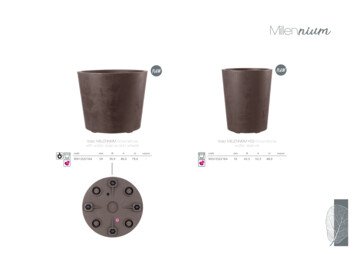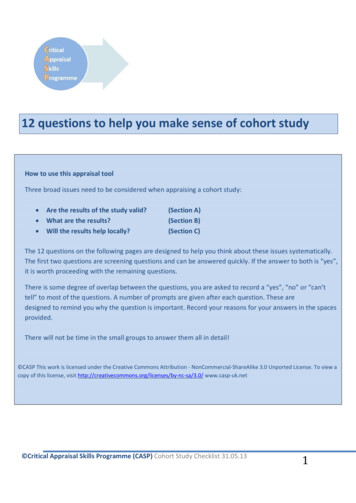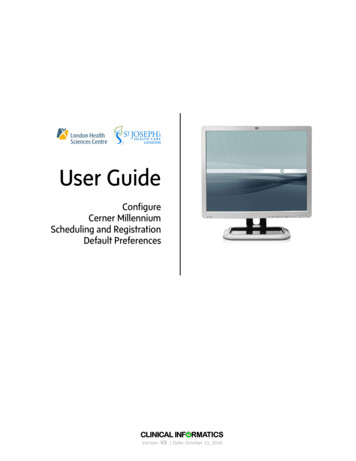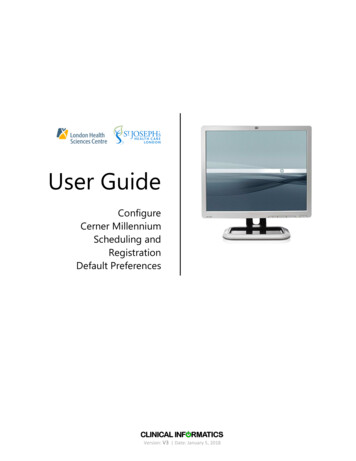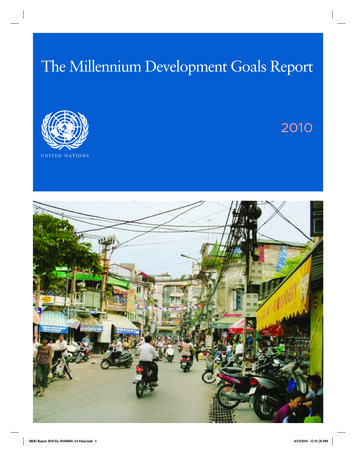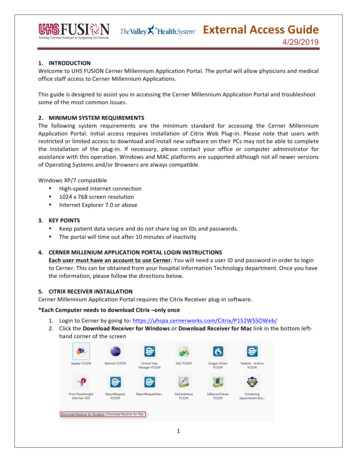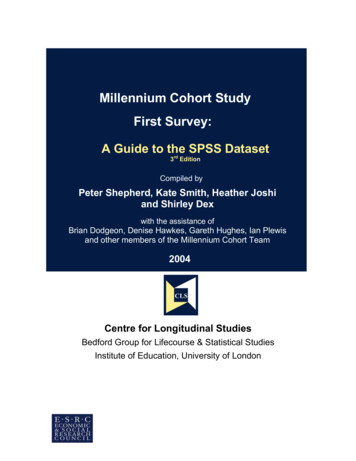
Transcription
Millennium Cohort StudyFirst Survey:A Guide to the SPSS Dataset3rd EditionCompiled byPeter Shepherd, Kate Smith, Heather Joshiand Shirley Dexwith the assistance ofBrian Dodgeon, Denise Hawkes, Gareth Hughes, Ian Plewisand other members of the Millennium Cohort Team2004Centre for Longitudinal StudiesBedford Group for Lifecourse & Statistical StudiesInstitute of Education, University of London
Millennium Cohort Study First Survey: A Guide to the SPSS DatasetCONTENTSACKNOWLEDGEMENTS . 6PREFACE . 7PART ONE. 81.1 Introduction.81.1.1 History . 81.1.2 Background to ESRC funding . 81.1.3 ESRC Funding of the Centre for Longitudinal Studies (CLS) . 91.1.4 Objectives . 101.1.5 Fieldwork Sub-contract . 101.1.6 Co-funding. 101.2 Sample Design .111.3 Sampling procedures .121.3.1 The use of Child Benefit Records . 121.3.2 Recruitment via Health Visitors . 131.4 Ethical Clearance .131.4.1 MREC. 131.4.2 Codes of Practice. 141.5 Survey Content.141.5.1 Development and Piloting . 141.5.2 First Pilot . 141.5.3 Dress Rehearsal Pilot . 141.5.4 Approaching the Main Stage. 151.5.5 Structure and Content of Final Instrument . 151.6 Developments and adaptations .171.6.1 Timing of Cohort births and age at interview. 171.6.2 Intensification and Extension of the Sample . 171.7 Fieldwork .181.7.1 Briefings . 181.7.2 Fieldwork Timetable . 181.7.3 Languages . 201.7.4 In field Tracing. 201.8 Achieved Sample .201.8.1 Response Rates. 221.9 Post field activities.241.9.1 Coding and Editing. 243
Millennium Cohort Study First Survey: A Guide to the SPSS DatasetPART TWO . 242.1 MCS First Survey Data .242.1.1 Variable names . 252.1.2 Variable labels. 262.1.3 Value labels. 272.1.4 Missing values. 272.1.5 Variable order. 272.1.6 Values . 282.1.7 Consistency. 282.1.8 Excluded variables . 282.1.9 Data Collection Errors . 282.1.9 Some useful variables. 302.1.10 Self-completion . 312.1.11 Proxy interview. 322.1.12 Identifiers. 332.1.13 Multiple births . 332.1.14 CAPI Derived Variables . 332.1.15 Other Derived Variables. 332.1.16 Weights . 332.2 Assessment of Data Quality.362.2.1 Household Module . 362.2.2 Module A: Non-resident parents . 362.2.3 Module B: Father’s involvement with baby. 372.2.4 Module C: Pregnancy, Labour and Delivery . 372.2.5 Module D: Baby’s health and development. 382.2.6 Module E: Childcare. 392.2.7 Module F: Grandparents and Friends . 402.2.8 Module G: Parent’s health. 402.2.9 Module H: Self-completion . 402.2.10 Module J: Employment and Education. 412.2.11 Module K: Housing and local area . 432.2.12 Module L: Interests and time with baby. 432.2.13 Proxy Module . 43PART THREE . 443.1 Future activities .443.1.1 Ecological Data - Neighbourhood Statistics . 444
Millennium Cohort Study First Survey: A Guide to the SPSS Dataset3.1.2 Health Visitor Survey. 443.1.3 Flagging . 443.1.4 Record Linkage . 443.1.5 Postal survey of assisted fertility treatment. 443.1.6 Feedback . 453.1.7 Tracing . 453.1.8 Second Sweep . 453.1.9 Relations with Users . 45PUBLICATIONS. 46APPENDICES . 47Appendix 1: MCS1 Management and Advisory Structure .47Appendix 2: Psychological Inventories .495
Millennium Cohort Study First Survey: A Guide to the SPSS DatasetACKNOWLEDGEMENTSWe wish to acknowledge the support for the survey of our principal funders: theEconomic and Social Research Council; the consortium of UK GovernmentDepartments (led by the Office for National Statistics); the governments of Wales,Scotland and Northern Ireland; and the International Centre for Child Studies.The work could not have been carried out successfully without the involvement ofover a hundred advisors drawn from researchers, policy makers and funders, whowe consulted throughout the design of the surveys, particular thanks to those whohave served on the MCS Advisory Committee. Further details are given in the bodyof this Guide, and in Appendix 1.Also: National Centre for Social Research (NatCen) researchers, programmers, fieldmanagers, and interviewers The staff of the Information Centre at Newcastle of the Department for Workand Pensions (formerly the Department of Social Security) The mothers, fathers and other family members of the babies who form theMillennium Birth Cohort.6
Millennium Cohort Study First Survey: A Guide to the SPSS DatasetPREFACEThis document has been prepared to accompany the 3rd version of the deposit(February 2004), with the UK Data Archive at the University of Essex, of data fromthe first survey of the Millennium Cohort Study. The dataset issued at this timecontains a number of corrections that have come to light in subsequent datacleaning, and supercedes the early editions. Data checking is on-going and it ispossible further corrections may be incorporated as the data and documentation areupdated in the future.The other elements of the deposit, to which reference will be made throughout thisdocument, are identified below. Users are advised that they will need to consult allelements of the documentation to gain a full understanding of the data.MCS Deposit: ElementsTitleFormatMillennium Cohort Study First Survey DatasetSPSSMillennium Cohort Study First Survey: Technical Report on SamplingWordMillennium Cohort Study First Survey: CAPI QuestionnaireDocumentation (National Centre for Social Research)WordMillennium Cohort Study First Survey: Technical Report on Fieldwork(National Centre For Social Research) To be deposited at a later dateWordMillennium Cohort Study First Survey: Code Book and Edit Instructions(National Centre for Social Research)WordMillennium Cohort Study First Survey: Interactive Data Dictionary forthe SPSS dataset (based on the SPSS Data Dictionary)IdealistforWindowsMillennium Cohort Study First Survey: Guide to the SPSS DatasetWordMillennium Cohort Study First Survey: Derived VariablesWord7
Millennium Cohort Study First Survey: A Guide to the SPSS DatasetPART ONE1.1 Introduction1.1.1 HistoryThe Millennium Cohort Study offers large-scale information about the New Century’sbabies, and the families who are bringing them up, for the four countries of theUnited Kingdom. Its First Sweep, carried out during 2001-2002 has laid thefoundations for a major new longitudinal research resource, taking a new “year long”cohort of around 19,000 babies. In England and Wales they were born over thetwelve months, starting in September 2000 in England and Wales, and over 13 ½months from late November 2000 in Scotland and Northern Ireland. Information hasbeen collected from parents when the babies were aged nine months. The sampledesign allowed for disproportionate representation of families living in areas of childpoverty, in the smaller countries of the UK and in areas with high ethnic minoritypopulations in England. The first survey recorded the circumstances of pregnancyand birth, as well as those of the all-important early months of life, and the social andeconomic background of the family into which the children have been born. Thismultidisciplinary baseline data will reveal the diversity of starting points from whichthese ‘Children of the New Century’ are setting out.The study's broad objective was to create a new multi-purpose longitudinal dataset,describing the diversity of backgrounds from which children born in the New Centuryare setting out on life. Additional government funding led by ONS has extended theobjectives to provide control cases for the National Evaluation of Sure Start, and toprovide sufficient cases for intra-country analysis of Wales, Scotland and NorthernIreland, raising the target sample from 15,000 to over 20,000 children.This report reviews the background to the data collection for the first survey of theMillennium Cohort, from its commissioning by the ESRC in early 2000 to its depositin the ESRC Data Archive in May 2003. It covers developing the funding and designof the project, the two pilot surveys and the main fieldwork in all four UK countriesand the subsequent coding and data preparation, along with unanticipatedchallenges and resulting modifications of original plans.The Millennium Cohort Study is the fourth of Britain’s world-renowned nationallongitudinal birth cohort studies. Each follows a large sample of individuals born overa limited period of time through the course of their lives, charting the effects ofevents and circumstances in early life on outcomes and achievements later on. Theyshow how histories of health, wealth, education, family and employment areinterwoven for individuals and vary between them. The data collected are used formany scientific and policy purposes.1.1.2 Background to ESRC fundingThe three original birth cohort studies followed cohorts born in Great Britain in oneweek each of 1946, 1958 and 1970. For a comparison of some of their findings see,Ferri, Bynner and Wadsworth (eds) (2003) Changing Britain: Changing Lives,Institute of Education, London. During the 1980s and 1990s funding for following up8
Millennium Cohort Study First Survey: A Guide to the SPSS Datasetthe existing cohorts was precarious, and none was forthcoming for starting a newstudy in the series. In 1998, the ESRC established a National Strategy forLongitudinal Data Resources which put the future funding of the 1958 and 1970cohorts on a firmer footing, alongside the British Household Panel Study. In 1999,the British government decided to mark passing of the Millennium with a new birthcohort study. The ESRC commissioned a feasibility study from Professor JonathanGershuny who held wide consultations with the research community. This resulted inan invitation to tender for the Principal Investigator role in a new Study and to submitexpressions of interest to carry out its fieldwork. These invitations were issued whenthe new Millennium was already two months old on February 23 2000.The original ESRC funding was for a study which in some ways resembled that ofthe previous cohorts, but which departed from the previous designs in the followingrespects: The sample was to include children born over a full twelve months rather thanone week, to include births in all seasons The sampled birth dates should include the birth dates in the year 2000, eventhough it might not be possible to start with birth in January The geographical coverage of the study was to include the whole of the UK The content should emphasize the social and economic circumstances of thefamilies The target sample size was to be 15000 The target interview length was constrained by a fieldwork budget of 1.7m The contractors were to consider sample designs allowing for the overrepresentation of ethnic and national minorities The first survey was to be carried out when the children were at about the sameage in months, as near as possible to 6 months oldA further contrast with the earlier surveys follows as concerns the mode of datacollection. Most of these conditions pointed towards fieldwork being carried out by aprofessional fieldwork agency, with experience of probability sampling and socialscientific questionnaires, administered by computer, rather than the mobilisation ofhealth visitors that had carried out the interviews shortly after the births of theprevious cohorts. Constraints on the available numbers of professional interviewers,and the consequent need to spread interviewing over time were also considerationsfavouring a wider span of birth dates than a single week.1.1.3 ESRC Funding of the Centre for Longitudinal Studies (CLS)The Principal Investigator (PI) contract for the Millennium Cohort Study, First Survey(MCS1) was awarded in May 2000, to a consortium based in three institutions:I. Institute of Education: Centre for Longitudinal Studies (John Bynner);II. University College London: Department of Community Epidemiology andPublic Health, (Michael Marmot), and Institute of Child Health, (CatherinePeckham);III. City University: Department of Psychology, (Dermot Bowler).The scientific leader of the project was Heather Joshi, based at CLS in the IoE, alongwith the internal management team.9
Millennium Cohort Study First Survey: A Guide to the SPSS DatasetHeather Joshi was confirmed as Director of the Millennium Cohort Study in October2001 when the Principal Investigator Contract for Sweep 2 was awarded to the CLSled consortium through the Joint Centre for Longitudinal Research. At that time thestudy was taken into the umbrella of the portfolio of longitudinal data resourcesoverseen by the ESRC’s National Strategy Committee for Longitudinal Data. Themanagement structure for the MCS1 can be found in Appendix 1.1.1.4 ObjectivesThe objectives of the first MCS survey were laid down in the proposal to the ESRC inMarch 2000:1. To chart the initial conditions of social, economic and health advantages anddisadvantages facing new children in the new century, capturing informationthat the research community of the future will require.2. To provide a basis for comparing patterns of development with the precedingcohorts.3. To collect information on previously neglected topics, such as fathers’involvement in the children’s care and development.4. To focus on the children’s parents as the most immediate elements of thechild’s ‘background’, charting their experience as mothers and fathers of thisyear’s babies, to record how they (and any other children in the family) areadapting to the newcomer, and what their aspirations for her/his future maybe.5. To emphasize intergenerational links including those back to the parents’ ownchildhood.6. To investigate the wider social ecology of the family, including, socialnetworks, civic engagement and community facilities and services, splicing ingeo-coded data when available1.1.5 Fieldwork Sub-contractAs there was only one expression of interest in the fieldwork contract after theFebruary Call, ESRC required the fieldwork sub-contract to be re-advertised. It tookCLS and partners just over two months to develop the design of the surveysufficiently to specify the Invitation to Tender for the fieldwork contract, and onemonth for three potential contractors to submit their proposals. Following posttendering negotiations to reduce the price as instructed by the tendering panel, TheNational Centre for Social Research (NatCen) was appointed to carry out thefieldwork at the end of September 2000, 7 months after the original commissioning.The fieldwork in Northern Ireland was sub-contracted by NatCen to Central SurveyUnit of NISRA (the Northern Ireland Statistics and Research Agency).1.1.6 Co-fundingDuring the last three months of 2000 a consortium of government Departments (ledby ONS) substantially supplemented resources available to the Survey.Thisenabled the length of the interview at Sweep 1 to be extended by 15 minutes fromthe 90 available with ESRC funds, and to increase the target sample size from 1500each in the Celtic countries - by 1500 in Wales, 1000 in Scotland and 500 in10
Millennium Cohort Study First Survey: A Guide to the SPSS DatasetNorthern Ireland. The target sample in England was also boosted by approx 2650cases in 35 additional disadvantaged wards to provide control cases for the NationalEvaluation of Sure Start. The ONS funding also supported work on later sweeps andenhancement of health and neighbourhood data most of whose results will comeafter the first deposit described hereSubstantial co-funding by government departments, over at least five years, hasbrought new objectives to the Study. One is for the MCS to provide controls for thenational evaluation of Sure Start described above. The governments of Wales,Scotland and Northern Ireland contributed to boosting the samples for the first sweepin Celtic countries in order to achieve adequate samples for analysis in the individualcountries. The ONS consortium also contributed to collecting ecological data,enhancing the health information and the preparation of reports and analysis.There has also been small scale but timely co-funding by the ICCS (InternationalCentre for Child Studies) to aid the attempts to reach and survey health visitors andto provide a thank-you voucher for participants in the first pilot.1.2 Sample DesignOne of the first tasks for the PI team was to select a sampling strategy and establishhow it could be operationalized in the tight timescale demanded by the survey. Itwas decided by mid July, that the sample of a years births should be tightly clusteredgeographically, and disproportionately stratified to over-represent areas with highproportions of: ethnic minorities in England, areas of high child poverty and the threesmaller countries of the UK respectively. It was decided to use the geography ofelectoral wards as a sampling frame. The Index of Deprivation 2000 (Noble et al(2000), Measuring multiple deprivation at the small area level: The indices of deprivation,2000. Final report for the DETR.) used wards with 1998 boundaries in England. Its childpoverty component provided as up to date as possible an indicator of wards withhigh proportions of children in families receiving means tested benefits.The sample for the first sweep included babies born between September 1 2000 andAugust 31 2001 in England and Wales, who will form an academic year cohort. InScotland and Northern Ireland the start date of the birthdays was delayed toNovember 23 2000 in order to avoid an overlap with an infant feeding survey beingcarried out in September and October. In the event the sampled cohort wasextended to 59 weeks of births to make up for a shortfall in numbers which becameapparent during fieldwork. The last eligible birth date in these countries was January11 2002.Children with sample birth dates were eligible for the survey if they were living in oneof approximately 400 electoral wards across the whole of the UK when they were 9months old.The disproportionately stratified design of the survey was to ensure adequaterepresentation of:11
Millennium Cohort Study First Survey: A Guide to the SPSS Dataset All UK countriesAreas in England with higher minority ethnic populations in 1991Disadvantaged areasThe estimated breakdown of the target sample for Sweep 1 is outlined in table 1below:Table 1 Millennium Cohort Sample Structure by stratum and country: wardsand babies aged 9 months (numbers of children in italics)CountryTotalwardstarget nosof children(of which, boostfrom eEngland20013146(babies in 35wards for SureStart 2646)1105511715258192606Wales733000(1500 babies 000 babies)321243301285NaNorthernIreland632000(500 babies 8,41319110,084192,6065,700’wards’ counts 49 amalgamations of small wards (‘superwards’) as units. See TechnicalReport on Sampling)1.3 Sampling procedures1.3.1 The use of Child Benefit RecordsAnother key decision was to take advantage of an offer by the Department of SocialSecurity (now DWP) to make Child Benefit records available to find the children. Wehad originally assumed there was no alternative to birth registration records. Wecame to favour the CB route, because of concern about non-response to the postalopt-in operated by ONS. The representativeness of the sample could be highlycompromised in relation to socially excluded groups, including those with poorliteracy or poor grasp of English. DWP ask people to opt-out, which is known to bemore inclusive of marginal and low literacy cases. The arrangement to use the DWPsystem was confirmed in September 2000However DWP do withdraw ‘sensitive cases’ from the issued sample. These includeparents of children who have died, or have been taken into care or where there is aninvestigation into benefit fraud, for example. At one point families who were incorrespondence with DWP for virtually any reason were being excluded, but the12
Millennium Cohort Study First Survey: A Guide to the SPSS Datasetcriteria for these exclusions were reviewed before MCS1 sampling started and in theevent fewer than 3% of cases were affected One of the reasons for exclusion was toavoid families who had also taken part in the Survey of Low Income Families (nowthe Families and Children Survey, FACS). This involved only 40 cases (out of over27,000).1.3.2 Recruitment via Health VisitorsBecause the Child Benefit records do not reveal all families who have moved into thesample wards as the child approaches 9 months of age, we attempted to findmovers-in with the help of Health Visitors. These local community healthprofessionals were expected to be aware of families transferring into these areas inthe course of their duties., They were asked to see if families moving into surveywards were willing to be recruited . They were also asked to inform and reassureother families, who might have received the opt-out, about the survey.It is difficult to quantify how important this reassurance may have been, but we doknow that health visitors reported 220 cohort in-moving families with children over 6months of age, however only 56 had not also been found by DWP. We also used ourHealth Visitor contacts to distribute a postal survey on local services in the sampleareas.There were several problems which may explain the rather disappointing result ofthis exercise. Firstly, helping with the survey was not part of the health visitor’salready demanding normal duties. Secondly, Health Visitors’ caseloads do not neatlycoincide with electoral wards, and thirdly there is no central list of Health Visitors foreasy contact. Tracking down the relevant Health Visitors or Supervisors proved timeconsuming, particularly in view of the reorganisation of the Community Care Trustsinto Primary Care Trusts during 2001. The exercise benefited vitally from the helpand experience of Neville Butler and the financial support of ICCS. It was aided byadditional ESRC funds for maps. We eventually distributed 3330 packs to HealthVisitors with the help of 306 supervisors.1.4 Ethical Clearance1.4.1 MRECThe process of gaining medical research ethical approval proved a major hurdle. Ashad been the practice with the previous cohort studies, medical research ethicalclearance was sought (in February 2001). This was as a general precaution forfuture health data collection and was specifically required because of the proposal toinvolve Health Visitors. Any research using NHS staff needs to be given suchclearance. We were directed to the South West Multi-Centre Research EthicsCommittee in March 2001, who felt that opt-out sampling could be coercive and failto obtain properly informed consent. They did however accept that written opt-insw
the SPSS dataset (based on the SPSS Data Dictionary) Idealist for Windows Millennium Cohort Study First Survey: Guide to the SPSS Dataset Word Millennium Cohort Study First Survey: Derived Variables Word . Millennium Cohort Study First Survey: A Guide to the SPSS Dataset 8 PART ONE 1.1 Introduction 1.1.1 History The Millennium Cohort Study offers large-scale information about the New Century .


